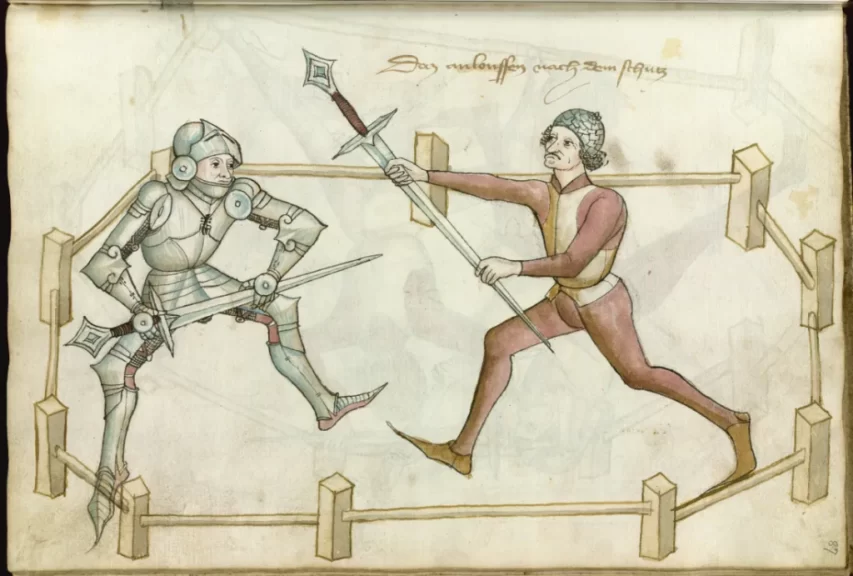Real Engineering
Published 18 Feb 2023
(more…)
May 28, 2023
This Gun Could Reach Space
May 19, 2023
They made a MOVIE about the discovery of Richard III’s remains!!!
Vlogging Through History
Published 16 Sept 2022Here’s a fantastic hour-long breakdown of the entire search and discovery process – https://www.youtube.com/watch?v=dsTyG…
(more…)
April 25, 2023
QotD: What is military history?
The popular conception of military history – indeed, the conception sometimes shared even by other historians – is that it is fundamentally a field about charting the course of armies, describing “great battles” and praising the “strategic genius” of this or that “great general”. One of the more obvious examples of this assumption – and the contempt it brings – comes out of the popular CrashCourse Youtube series. When asked by their audience to cover military history related to their coverage of the American Civil War, the response was this video listing battles and reflecting on the pointless of the exercise, as if a list of battles was all that military history was (the same series would later say that military historians don’t talk about about food, a truly baffling statement given the important of logistics studies to the field; certainly in my own subfield, military historians tend to talk about food more than any other kind of historian except for dedicated food historians).
The term for works of history in this narrow mold – all battles, campaigns and generals – is “drums and trumpets” history, a term generally used derisively. The study of battles and campaigns emerged initially as a form of training for literate aristocrats preparing to be officers and generals; it is little surprise that they focused on aristocratic leadership as the primary cause for success or failure. Consequently, the old “drums and trumpets” histories also had a tendency to glory in war and to glorify commanders for their “genius” although this was by no means universal and works of history on conflict as far back as Thucydides and Herodotus (which is to say, as far back as there have been any) have reflected on the destructiveness and tragedy of war. But military history, like any field, matured over time; I should note that it is hardly the only field of history to have less respectable roots in its quite recent past. Nevertheless, as the field matured and moved beyond military aristocrats working to emulate older, more successful military aristocrats into a field of scholarly inquiry (still often motivated by the very real concern that officers and political leaders be prepared to lead in the event of conflict) the field has become far more sophisticated and its gaze has broadened to include not merely non-aristocratic soldiers, but non-soldiers more generally.
Instead of the “great generals” orientation of “drums and trumpets”, the field has moved in the direction of three major analytical lenses, laid out quite ably by Jeremy Black in “Military Organisations and Military Charge in Historical Perspective” (JMH, 1998). He sets out the three basic lenses as technological, social and organizational, which speak to both the questions being asked of the historical evidence but also the answers that are likely to be provided. I should note that these lenses are mostly (though not entirely) about academic military history; much of the amateur work that is done is still very much “drums and trumpets” (as is the occasional deeply frustrating book from some older historians we need not discuss here), although that is of course not to say that there isn’t good military history being written by amateurs or that all good military history narrowly follows these schools. This is a classification system, not a straight-jacket and I am giving it here because it is a useful way to present the complexity and sophistication of the field as it is, rather than how it is imagined by those who do not engage with it.
[…]
The technological approach is perhaps the least in fashion these days, but Geoffery Parker’s The Military Revolution (2nd ed., 1996) provides an almost pure example of the lens. This approach tends to see changing technology – not merely military technologies, but often also civilian technologies – as the main motivator of military change (and also success or failure for states caught in conflict against a technological gradient). Consequently, historians with this focus are often asking questions about how technologies developed, why they developed in certain places, and what their impacts were. Another good example of the field, for instance, is the debate about the impact of rifled muskets in the American Civil War. While there has been a real drift away from seeing technologies themselves as decisive on their own (and thus a drift away from mostly “pure” technological military history) in recent decades, this sort of history is very often paired with the others, looking at the ways that social structures, organizational structures and technologies interact.
Perhaps the most popular lens for military historians these days is the social one, which used to go by the “new military history” (decades ago – it was the standard form even back in the 1990s) but by this point comprises probably the bulk of academic work on military history. In its narrow sense, the social perspective of military history seeks to understand the army (or navy or other service branch) as an extension of the society that created it. We have, you may note, done a bit of that here. Rather than understanding the army as a pure instrument of a general’s “genius” it imagines it as a socially embedded institution – which is fancy historian speech for an institution that, because it crops up out of a society, cannot help but share that society’s structures, values and assumptions.
The broader version of this lens often now goes under the moniker “war and society”. While the narrow version of social military history might be very focused on how the structure of a society influences the performance of the militaries that created it, the “war and society” lens turns that focus into a two-way street, looking at both how societies shape armies, but also how armies shape societies. This is both the lens where you will find inspection of the impacts of conflict on the civilian population (for instance, the study of trauma among survivors of conflict or genocide, something we got just a bit with our brief touch on child soldiers) and also the way that military institutions shape civilian life at peace. This is the super-category for discussing, for instance, how conflict plays a role in state formation, or how highly militarized societies (like Rome, for instance) are reshaped by the fact of processing entire generations through their military. The “war and society” lens is almost infinitely broad (something occasionally complained about), but that broadness can be very useful to chart the ways that conflict’s impacts ripple out through a society.
Finally, the youngest of Black’s categories is organizational military history. If social military history (especially of the war and society kind) understands a military as deeply embedded in a broader society, organizational military history generally seeks to interrogate that military as a society to itself, with its own hierarchy, organizational structures and values. Often this is framed in terms of discussions of “organizational culture” (sometimes in the military context rendered as “strategic culture”) or “doctrine” as ways of getting at the patterns of thought and human interaction which typify and shape a given military. Isabel Hull’s Absolute Destruction: Military Culture and the Practices of War in Imperial Germany (2006) is a good example of this kind of military history.
Of course these three lenses are by no means mutually exclusive. These days they are very often used in conjunction with each other (last week’s recommendation, Parshall and Tully’s Shattered Sword (2007) is actually an excellent example of these three approaches being wielded together, as the argument finds technological explanations – at certain points, the options available to commanders in the battle were simply constrained by their available technology and equipment – and social explanations – certain cultural patterns particular to 1940s Japan made, for instance, communication of important information difficult – and organizational explanations – most notably flawed doctrine – to explain the battle).
Inside of these lenses, you will see historians using all of the tools and methodological frameworks common in history: you’ll see microhistories (for instance, someone tracing the experience of a single small unit through a larger conflict) or macrohistories (e.g. Azar Gat, War in Human Civilization (2008)), gender history (especially since what a society views as a “good soldier” is often deeply wrapped up in how it views gender), intellectual history, environmental history (Chase Firearms (2010) does a fair bit of this from the environment’s-effect-on-warfare direction), economic history (uh … almost everything I do?) and so on.
In short, these days the field of military history, as practiced by academic military historians, contains just as much sophistication in approach as history more broadly. And it benefits by also being adjacent to or in conversation with entire other fields: military historians will tend (depending on the period they work in) to interact a lot with anthropologists, archaeologists, and political scientists. We also tend to interact a lot with what we might term the “military science” literature of strategic thinking, leadership and policy-making, often in the form of critical observers (there is often, for instance, a bit of predictable tension between political scientists and historians, especially military historians, as the former want to make large data-driven claims that can serve as the basis of policy and the later raise objections to those claims; this is, I think, on the whole a beneficial interaction for everyone involved, even if I have obviously picked my side of it).
Bret Devereaux, “Collections: Why Military History?”, A Collection of Unmitigated Pedantry, 2020-11-13.
April 20, 2023
We strongly believe in academic freedom, except when research turns up “inconvenient” results
Tom Knighton on a sad situation at a London university with publicly funded research having arrived at a politically unwelcome result:

Two people at EuroPride 2019 in Vienna holding an LGBTQ+ pride rainbow flag featuring a design by Daniel Quasar; this variation of the rainbow flag was initially promoted as “Progress” a PRIDE Flag Reboot.
Photo by Bojan Cvetanović via Wikimedia Commons.
In the UK, one academic decided to look at the “gender wars”, particularly how academics feel silenced on the whole trans issue.
It sounds to me like both an interesting subject for study and one that might be very necessary in this day and age.
It seems that while the researcher in question was approved to study it, her findings are problematic and that got her canned.
From The Telegraph:
A university has “confiscated” the findings of an academic studying Britain’s gender wars in a row over her “dangerous” research data, The Telegraph can reveal.
Dr Laura Favaro began the first ever taxpayer-funded study into whether social scientists at universities feel censored over their views on transgender issues in March 2020 at City, University of London.
But it has descended into chaos, with the study’s author allegedly hounded out of the university, stripped of the findings she collected and barred from publishing them amid claims of transphobia.
[…]
Her study involved 50 individual interviews with academics in gender studies who identified as feminists, a representative survey of social scientists with 650 responses and hundreds of documents and tweets.
Scholars told her that they had threats of violence in the gender debate, hostility from colleagues, and others said they felt their careers “can’t survive that sort of backlash”, and that they have to have “secret conversations” to avoid reprisal and because “we are all so afraid”.
Her final work has not been published, as it was derailed by complaints about an article for Times Higher Education in which she warned that “a culture of discrimination, silencing and fear has taken hold”.
Following this, she says, her line managers told her that the study had “become an institutionally sensitive issue” and that “City considers my data to be dangerous” and is “frightened of making it public”.
So, what Favaro was finding was accurate.
That’s the big takeaway for me here. She said that academics were concerned about being attacked or that they had been because they didn’t play along with the trans agenda, and she was attacked and basically canceled because of it.
What’s even dumber is that Favaro was lured to City University from Spain so that she could conduct this research. She received roughly £28,000 from the British government via two different governmental entities to conduct the research.
Then she was silenced because the research found inconvenient truths.
That’s not what academia is supposed to be about. That’s not what academic freedom is about.
Freedom of any kind requires one to accept things that we would rather not have to accept. If you’re not free to say or do something that doesn’t actually harm a specific person but is otherwise objectionable, you don’t really have any freedom.
March 28, 2023
The Rise of the US Army Air Forces
World War Two
Published 27 Mar 2023The United States Army Air Force, USAAF, is the most powerful air force in the world. Alongside the Royal Air Force, it is winning the air war against the Luftwaffe. But things weren’t always like this. At the outbreak of war, the USAAF could not hold a candle to its allies or enemies. How have the Americans managed to turn things around?
(more…)
March 15, 2023
Not only is the science “settled” … it’s already in the school textbooks
David Friedman on his attempts to follow up on claims made in a textbook on climate change already in use in US public schools:
Introduction to Modern Climate Change by Andrew Dessler is an elementary climate science textbook, now in its third edition. In Chapter 9, “Impacts of Climate Change”, it has:
Scientists predict that sea level will rise 47 to 73 cm (19 to 29 inches) above 1995–2014 levels by 2100. This may not sound like a significant challenge, but it is much larger than the 18 cm of sea level experienced over the twentieth century, which is already challenging for many who live near sea level. Like temperature, these predictions of sea-level rise might sound small but, also like temperature, they are not. In Florida, for example, a sea-level rise in the middle of the projected range would inundate 9 percent of Florida’s current land area at high tide. This includes virtually all of the Florida Keys as well as 70 percent of Miami-Dade County. Almost one-tenth of Florida’s current population, or nearly 2 million people, live in this vulnerable zone, and it includes residential real estate valued at hundreds of billions of dollars. It also includes important infrastructure, such as two nuclear reactors, three prisons, and 68 hospitals.
That struck me as implausible, given what else I had seen on the effect of sea level rise. The footnote for the claim was to Stanton and Ackerman (2007), which turned out to be not a peer reviewed journal article but a report commissioned by the Environmental Defense fund, an environmentalist group. It includes the same claims, but for 27 inches of sea-level rise not the 24 inches that is Dessler’s “middle of the projected range”. It refers the reader to Appendix C for “detailed sources and methodology”. Going there, I found:
To estimate the impact of sea-level rise on land area, populations, and public and private assets and infrastructure, we began with a 1:250,000 Digital Elevation Model (DEM) map of the State of Florida, and divided the state into “vulnerable” and “not vulnerable” zones demarcated by 1.5 meters of elevation and other factors described by Titus and Richman (2000) as corresponding to 27 inches of sea-level rise.
So what they are showing as the vulnerable area is not the 27 inch or 24 inch contour but the 1.5 meter (5 feet) contour. The explanation, from Titus, J.G. and C. Richman (2001). “Maps of lands vulnerable to sea level rise: modeled elevations along the US Atlantic and Gulf coasts“. Climate Research 18: 205–228, a journal article written by two EPA people and presumably peer reviewed:
Thus, at a typical site, the 1.5-meter contour would be flooded by spring high tides (i.e., high tides during new and full moons) when sea level rises 80 cm
Figure 1 below (Titus and Richman Figure 4) is a map of Florida with the region within the 1.5 meter contour colored red, the region between 1.5 and 3.5 blue. Dessler’s middle of the projected range is 60 cm. Stanton and Ackerman’s 27 inches is 68.6 cm. The map shows what its authors claim would be flooded at 80cm.
Figure 2 below is a population density map of Florida from Wikipedia to which I have added the 1.5m contours from Figure 1. The large flooded area on the southern tip of Florida includes none of the densely populated area around Miami; only one of the tiny areas farther north appears to be in part on a populated area. That is not surprising — areas very close to sea level are likely to be marsh, in this case the everglades, and poor places to build on.
Stanton and Ackerman claim that their own calculations, using data bases of elevation and population, produce a total population in the at-risk area of 1.5 million. That was the figure Dessler gave in his first edition, presumably increased to almost 2 million in the third edition to reflect the increase in Florida’s population. Figure 2 shows why I don’t believe it. The flooded areas are in places almost all of which have very low population density, making it hard to see how flooding nine percent of the land area, most of it in the everglades, can flood almost ten percent of the population. Even if all of the Florida Keys are flooded, their total population is only about 80,000.
That problem is in addition to the fact that Dessler’s claim is for 60 cm of sea level rise, Stanton and Ackerman’s, from which Dessler got his figure for how many people are flooded, is for 68.6 cm (27 inches), and Titus and Richman get the 1.5 m contour that Stanton and Ackerman say they are using by assuming 80cm of sea level rise. Further reasons for suspicion are that Stanton and Ackerman gave figures for sea level rise substantially higher than either the IPCC figure at the time or the current IPCC figure, which suggests that they were trying to make the consequences of climate change look as scary as possible, and that they write “1.5 meters of elevation and other factors described by Titus and Richman (2000) as corresponding to 27 inches of sea-level rise” when Titus and Richman actually describe 1.5 meters as corresponding to 80 cm (31.5 inches) of sea level rise.
December 28, 2022
What we still don’t know about historical European swordfighting
I was for many years a member of the SCA partly for the attraction of the historical period and partly for the swordfighting. The Society developed a (mostly) safe simulation of (some) medieval combat styles and later introduced (some) renaissance rapier combat as well (initially borrowing equipment standards from modern sport fencing). Around the time the SCA began to consider expanding from high medieval sword-and-shield styles, separate organizations in Europe and the United States sprang up to be more consciously historical in how they recreated historical blade combat, these groups are often collectively referred to as Historical European Martial Arts (HEMA) or Western Martial Arts (WMA). The foundation documents for HEMA and other historical combat enthusiasts are the various surviving manuals of swordmasters and fencing school owners which cover a kaleidoscope of weapons, techniques, advice, and how-to illustrations … some of which appear to be physically impossible for ordinary human beings:
The ultimate experts in medieval sword fighting were the “fight masters” – elite athletes who trained their disciples in the subtle arts of close combat. The most highly renowned were almost as famous as the knights they trained, and many of the techniques they used were ancient, dating back hundreds of years in a continuous tradition.
Little is known about these rare talents, but the scraps of information that have survived are full of intrigue. Hans Talhoffer, a German fencing master with curly hair, impressive sideburns and a penchant for tight body suits, had a particularly chequered past. In 1434, he was accused of murdering a man and admitted abducting him in the Austrian city of Salzburg.
Fight masters worked with a grisly assortment of deadly weapons. The majority of training was dedicated to fencing with the longsword, or the sword and buckler (a style of combat involving holding a sword in one hand, and a small shield in the other). However, they also taught how to wield daggers, poleaxes, shields, and even how to fight with nothing at all, or just a bag of rocks (more on this later).
It’s thought that some fight masters were organised into brotherhoods, such as the Fellowship of Liechtenauer – a society of around 18 men who trained under the shadowy grandmaster Johannes Lichtenauer in the 15th Century. Though details about the almost-legendary figure himself have remained elusive, it’s thought he led an itinerant life, travelling across borders to train a handful of select proteges and learn new fencing secrets.
Other fight masters stayed closer to home – hired by dukes, archbishops and other assorted nobles to train themselves and their guards. A number even set up their own “fight schools”, where they gathered less wealthy students for regular weekly sessions.
[…]
For all their beauty, the hand-drawn works could also be decidedly bloodthirsty. In Talhoffer’s 1467 manual, neat sequences of moves that look almost like dancing end abruptly with swords through eye-sockets, violent impalings, and casual instructions to beat the opponent to death. Some signature techniques even have names – chilling titles like the “wrath-hew”, “crumpler”, “twain hangings”, “skuller” and “four openings”.
Despite passing through countless generations of owners, and – in some cases – centuries of graffiti, burns, theft, and mysterious periods of vanishment from the historical record, a surprising number survive today. This includes at least 80 codexes from German-speaking regions alone.
Impossible moves and missing clues
But there’s a problem. Many of the techniques in combat manuals, also known as “fechtbücher“, are convoluted, vague, and cryptic. Despite the large corpus of remaining books, they often offer surprisingly little insight into what the fight master is trying to convey.
“It’s famously difficult to take these static unmoving woodcut images, and determine the dynamic action of combat,” says Scott Nokes, “This has been a topic of debate, research and experimentation for generations.”
On some occasions these manuals seem to depict contortions of the body that are physically impossible, while those that attempt to convey moves in three dimensions sometimes give combatants extra arms and legs that were added in by accident. Others contain instructions that are frustratingly opaque – sometimes depicting actions that don’t seem to work, or building upon enigmatic moves that have long-since been lost.
Oddly, the text is often written as poetry, rather than prose – and a few authors even made it hard to interpret their works on purpose.
Lichtenauer recorded his instructions in obscure verses which remain almost incomprehensible today – one expert has gone so far as to call them “gibberish”. According to a contemporary fight master he trained, the grandmaster wrote in “secret words” to prevent them from being intelligible to anyone who didn’t value his art highly enough.
Even when it is possible to decipher what a combat manual is describing or demonstrating, some experts suspect that crucial contextual information is always missing.
October 8, 2022
QotD: Does homework, well, work? ¯\_(ツ)_/¯
Yesterday I wrote about bottlenecks to learning. I wanted to discuss the effectiveness of homework. If it works well, that would suggest students are bottlenecked on examples and repetition. If it works poorly, it would have to be something else.
Unfortunately, all the research on this (showcased in eg Cooper 2006) is terrible.
Most studies cited by both sides use “time spent doing homework” as the independent variable, then correlate it with test scores or grades. If students who do more time on homework get better test scores, they conclude homework works; otherwise, that it doesn’t.
One minor complaint about this methodology is that we don’t really know if anyone is reporting time spent on homework accurately. Cooper cites some studies showing that student-reported time-spent-on-homework correlates with test scores at a respectable r = 0.25. But in the same sample, parent-reported time-spent-on-homework correlates at close to zero. Cooper speculates that the students’ estimates are better than the parents’, and I think this makes sense — it’s easier to reduce a correlation by adding noise than to increase it — but in the end we don’t know. According to a Washington Post article, students in two very similar datasets reported very different amounts of time spent on homework — maybe because of the way they asked the question? I don’t know, self-report from schoolchildren seems fraught.
But this is the least of our problems. This methodology assumes that time spent on homework is a safe proxy for amount of homework. It isn’t. Students may spend less time on homework because they’re smart, find it easy, and can finish it very quickly. Or they might spend more time on homework because they love learning and care about the subject matter a lot. Or they might spend more time because they’re second-generation Asian immigrants with taskmaster parents who insist on it being perfect. Or they might spend less time because they’re in some kind of horrible living environment not conducive to sitting at a desk quietly. All of these make “time spent doing homework” a poor proxy for “amount of homework that teacher assigned” in a way that directly confounds a homework-test scores correlation. Most studies don’t bother to adjust for these factors. The ones that do choose a few of them haphazardly, make wild guesses about what model to use, and then come up with basically random results.
Both homework proponents (Harris Cooper) and opponents (Alfie Kohn) briefly nod to this problem, then take these studies seriously anyway. If you do that, you find that probably homework isn’t helpful in elementary school, but might be helpful during high school (though some people disagree with either half of that statement). But why would you take these seriously?
Scott Alexander, “Nobody Knows How Well Homework Works”, Astral Codex Ten, 2022-07-07.
October 4, 2022
“… apparently the future of science is BAJEDI (Belonging Accessibility Justice Equity Diversity and Inclusion), which is quite a bit cooler than mere DEI”
And you thought the stuffy old National Science Foundation was only supporting pale, stale, cisgendered white male research? Think again!
I’ve written many times about the National Science Foundation and its increasingly politicized conception of “science”. As an independent federal agency with a nearly $9 billion budget, the NSF is a behemoth in the world of academic science, shaping research agendas and the future of the professoriate. And apparently the future of science is BAJEDI (Belonging Accessibility Justice Equity Diversity and Inclusion), which is quite a bit cooler than mere DEI. Here’s a current funding opportunity for scientists:
The federal agency that funds research projects like “Probing Nucleation and Growth Dynamics of Lithium Dendrites in Solid Electrolytes” is moving hard into the business of social justice, with career-making grants that will focus STEM researchers on the problem of racial grievances. Here’s how much money is available for that racial equity program:
The premise underlying this turn toward equity-focused science projects is that “science scholars who are underrepresented in STEM produce higher rates of scientific novelty”. Innovation is grounded in race and ethnicity; the more gloriously intersectional you are, the more creative you become. Imagine the boldness of a transgendered Asian Pacific Islander astrophysics, and how much newer and fresher our conception of the universe is when it doesn’t come from straight white males.
And so the NSF wants to fund “diversity champions” who will freshen up our science with BIPOC innovation — which means adding more sociologists to the team of geophysicists: “When developing proposals, the PI team should acknowledge the need for increased engagement from social and behavioral science experts to address issues related to BAJEDI in the geosciences and include these best practices and experts in proposed projects.” […]
It’s a real cultural revolution in the world of academic science.
September 9, 2022
The Velvet Glove and Sparrow II missiles; A Beginners Guide To Post-War Bomber Interception Tactics
Polyus Studios
Published 14 Jul 2018The Velvet Glove was a semi-active guided missile system developed by the Canadian Armament Research and Development Establishment. Its successor, the Sparrow II, was developed by Canadair in association with the US Air Force. This is the story of the development of the missiles in the context of contemporary weapons systems.
(more…)
August 29, 2022
“Follow the science!”, “No, not like that!”
Chris Bray recounts his experiences when he “followed the science” over the Wuhan Coronavirus:
It’s happening again, and so is the response. It’s becoming our one persistent cultural cycle.
During the first availability of the Covid-19 “vaccines” — which don’t prevent transmission or infection, but we changed the meaning of that word, so shut up shut up shut up — I did what I usually do: I thought about the past to try to make sense of the present. If we’ve instantly produced safe and effective vaccines for SARS-CoV-2, I wondered, why didn’t we do the same for SARS-CoV-1? It took less than five minutes to answer that question:
So scientists did come up with a vaccine for SARS-CoV-1, but when they gave it to animals, it made the animals extremely susceptible to severe illness when they were “challenged” with the virus again — “suggesting hypersensitivity to SARS-CoV components was induced”. And so, the authors of that 2012 paper argued, “Caution in proceeding to application of a SARS-CoV vaccine in humans is indicated.”
Because I believe in science, I followed that advice, and I told my doctor that I was following that advice — and that I wasn’t terribly concerned about Covid-19 anyway, so whatever. I would be cautious about injecting a novel medical product into my body: I would wait, calmly. She assured me that there was no scientific shortcutting at all in the development of the vaccines for SARS-CoV-2, which were absolutely known to be 100% safe and effective, but she also agreed that there was nothing wrong with watching and waiting for a few months.
I meant it. At that point, I hadn’t refused the vaccines — I had just decided that I would wait for a bit to see how they played out once they’d been injected into a few billion human lab rats.
And then the shaming started. I was uninvited from a family event, and ordered to stay away — and then, after a short pause, repeatedly shamed by email as a disgusting selfish pig who made the family sick with my ignorance and selfishness. (Distant family, thankfully.) The public sphere came alive with this message, and Joe Biden let me know that his patience was wearing thin for my kind. Social media was a daily fear bath, and consumed with shaming rituals.
It was exactly that message that turned my skepticism, my preference for watching and waiting, into a flat and permanent refusal. People said they were talking about science — in a vicious flood of hyperemotional shaming language, the hysterical tone and substance of which made it clear that they weren’t talking about science at all. They were talking about their fearfulness and their weakness; they were talking about their cowardice, and about the shame they felt at finding their fear of the air wasn’t shared. The shaming made me contemptuous; it secured my commitment to resist.
So now comes a new flood of shaming messages, assuring people that mere political disagreement is a sure sign of monstrous cruelty and hate.
June 27, 2022
High Altitude Research Project and the Martlet Launch Vehicles; Gerald Bull’s dream of a space gun
Polyus Studios
Published 26 Jun 2022Support me on Patreon – https://www.patreon.com/polyusstudios
In 1968, 7 countries were operating satellites in orbit, while only 3 countries had the ability to launch one themselves. But they were on the verge of being joined by a Canadian university. Starting in the early 1960s, Montreal, Quebec based McGill University developed and began testing an ambitious concept to place small satellites into orbit. It was the culmination of decades of pioneering work across multiple fields. It was the High Altitude Research Project and the Martlet orbital launch vehicle.
Music:
Denmark – Portland Cello Project
Your Suggestions – Unicorn HeadsChapters:
0:00 Introduction
0:28 Bull’s early career
3:00 Birth of the Program
7:47 Getting HARP off the ground
10:52 Martlet 1
13:26 Early Martlet 2
15:41 Martlet 3
18:05 Enhanced Martlet 2s
21:40 Other HARP Guns
24:19 Quest for an Orbital Capability, the 2G-1
27:53 Satellite Delivery Model, Martlet 4
30:27 Advanced gun research
31:30 Hard times for HARP
32:30 Bull’s Ambition Gets The Best Of Him
35:28 Legacy of the HARP Project
June 18, 2022
“Fusion is 30 years away and always will be” … how much progress have we made toward practical fusion energy?
One of the readers of Scott Alexander’s Astral Codex Ten has contributed a review of The Future of Fusion Energy by Jason Parisi and Justin Ball. This is one of perhaps a dozen or so anonymous reviews that Scott publishes every year with the readers voting for the best review and the names of the contributors withheld until after the voting is finished:
Fusion is the power which lights the stars. It is the source of all elements heavier than hydrogen in the universe. Wouldn’t it be great if we could use and control this power here on Earth?
I predict that we will get fusion before 2035 (80%) or 2040 (90%). I am a professional plasma physicist, a fusioneer if you will, so I probably know more about this subject than you, but am likely to overemphasize its importance.
The Future of Fusion Energy is the best introduction to fusion that I know. I can confirm that the information it contains is common knowledge among plasma physicists. My parents, who are not physicists, can confirm that it is accessible and interesting to read.
Things are changing fast in fusion right now, and The Future of Fusion Energy is already out of date in some important ways. I will summarize our quest for fusion as it is portrayed in the book, describe what has happened in the field since 2018, and make some predictions about where we go from here. The predictions are my own and do not reflect the opinions of Parisi or Ball.
Why Don’t We Have Fusion Already?
There is an old joke:
Fusion is 30 years away and always will be.
What happened? Why has fusion failed to deliver on its promise in the past?
By the 1970s, it was apparent that making fusion power work is possible, but very hard. Fusion would require Big Science with Significant Support. The total cost would be less than the Apollo Program, similar to the International Space Station, and more than the Large Hadron Collider at CERN. The Department of Energy put together a request for funding. They proposed several different plans. Depending on how much funding was available, we could get fusion in 15-30 years.
How did that work out?
Along with the plans for fusion in 15-30 years, there was also a reference: “fusion never”. This plan would maintain America’s plasma physics facilities, but not try to build anything new.
Actual funding for fusion in the US has been less than the “fusion never” plan.
The reason we don’t have fusion already is because we, as a civilization, never decided that it was a priority. Fusion funding is literally peanuts: In 2016, the US spent twice as much on peanut subsidies as on fusion research.
May 22, 2022
HMCS Bras D’Or; The world’s fastest warship and the pinnacle of hydrofoil development in Canada
Polyus Studios
Published 3 Feb 2022Don’t forget to like the video and subscribe to my channel!
Support me on Patreon – https://www.patreon.com/polyusstudiosHMCS Bras D’Or was the pinnacle of over 100 years of hydrofoil development in Canada. Starting with Alexander Graham Bell and ending with the Proteus, hydrofoils held the promise of faster travel over the waves. Unfortunately the technology never found a comfortable fit in either military or civil fleets. It was designed to be an ASW hunter but by the time she was ready, the Navy was settled on using the now familiar Destroyer/Helicopter combos.
0:00 Introduction
0:29 Alexander Graham Bell and Casey Baldwin
2:28 The R-100 Massawippi
5:46 The R-103 Baddeck
7:15 The Rx
8:48 Anti-submarine warfare hydrofoil concept
12:24 FHE-400 Bras D’Or
17:23 Testing and refinement
19:25 Cancellation
20:18 Proteus
20:45 ConclusionMusic:
“Denmark” – Portland Cello Project
“Your Suggestions” – Unicorn Heads#BrasDor #CanadianAerospace #PolyusStudios
April 28, 2022
Why yeast extract is in tons of foods (and why it’s delicious)
Adam Ragusea
Published 13 Dec 20212008 paper in which Turkish scientists found 50ºC for 24 hours is the best time and temp for yeast autolysis: https://www.researchgate.net/publicat…
1916 paper in which American scientists found that yeast extract cured beriberi in pigeons fed only white rice, because B vitamins: https://www.google.com/books/edition/…
1995 book chapter covering Justus Von Liebig’s experiments with yeast extract: https://www.google.com/books/edition/…
2002 press release from the Marmite company covering their history (much more thorough than what’s currently on their website): http://webarchive.loc.gov/all/2002111…
Vegemite. There, I said it.














